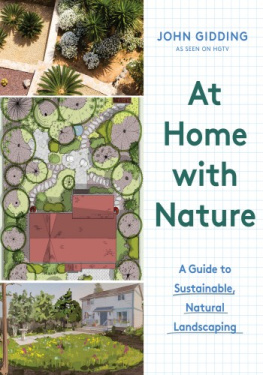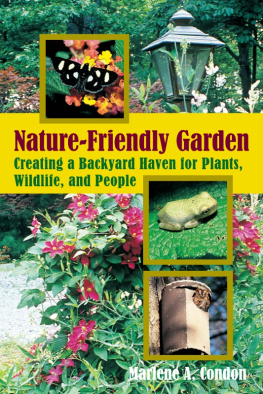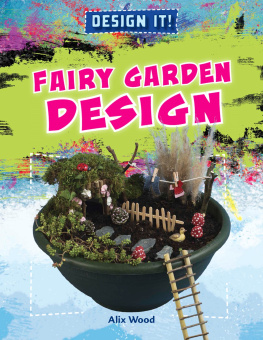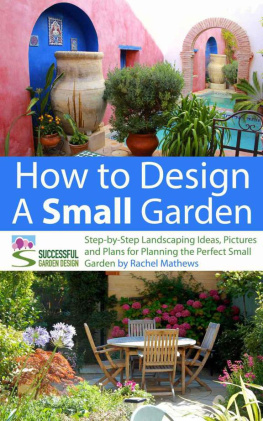the naturescaping workbook
the naturescaping workbook
A Step-by-Step Guide for Bringing Nature to Your Backyard
BY Beth ODonnell Young
WITH PHOTOGRAPHS BY Karen Bussolini

Text and illustrations copyright 2011 by Beth ODonnell Young. All rights reserved.
Copyright to photographs 2011 Karen Bussolini, Andy Hoffman, Lauren Knight,
Dave Reed, Larry Thornton, Beth ODonnell Young, and Bill Young.
Photography credits appear on .
Spot photos copyright :
Pavel Lebedinsky; : malerapaso;
: Alexander Raths.
Published in 2011 by Timber Press, Inc.
The Haseltine Building
133 S.W. Second Avenue, Suite 450
Portland, Oregon 97204-3527
www.timberpress.com | 2 The Quadrant
135 Salusbury Road
London NW6 6RJ
www.timberpress.co.uk |
Printed in China
Design by Nicki Brandt
Library of Congress Cataloging-in-Publication Data
Young, Beth ODonnell.
The naturescaping workbook: a step-by-step guide for
bringing nature to your backyard/Beth ODonnell Young;
with photographs by Karen Bussolini1st ed.
p. cm.
Includes bibliographical references and index.
ISBN 978-1-60469-118-4
1. Natural landscaping. 2. Natural gardensDesign. I. Bussolini, Karen.
II. Title. III. Title: A step-by-step guide for bringing nature to your backyard.
SB439.Y68 2011
635.95dc22
2011012385
A catalog record for this book is also available from the British Library.
 TO MY PARENTS
TO MY PARENTS 
John and Shirley ODonnell
with love and gratitude
contents
WORKSHEETS

When you visit your local natural areas often, you will learn to design like nature. In this near-to-natural garden, a flowering redbud heralds the beginning of spring, just like in the surrounding foothills. Design by Ana Hajduk.
acknowledgments
My parents gave me love and encouragement and always told meand my three sistersthat we could do anything we set our minds to do. Mother said I was beautiful, strong, and complicated, but she is all that and so much more. Dad has always been proud of me; I can see it in his eyes when he looks at me.
Teresa Matteson of the Benton Soil and Water Conservation District, Tom Kaye of the Institute for Applied Ecology, Jeff Picton of Chintimini Wildlife Center, James Cassidy of the Oregon State University (OSU) Department of Crop and Soil Science, Bill Proebesting and Tom Cook of the OSU Department of Horticulture (both retired), Mark Taratoot of the City of Corvallis, Linda McMahan of the OSU Extension Service, writer and wildlife gardener Lisa Albert, and professional hydrologist Chip Andrus generously volunteered to share their expertise with the students in my Naturescape Your Yard classes; they are gems and I consider them coauthors of this book. Colin Gillin, president of the American Association of Wildlife Veterinarians, and Jeff Gillman of the University of Minnesota Department of Horticultural Science each gave me quick and accurate technical advice whenever I asked.
The citizens of Corvallis, Oregon, who signed up for my Naturescape Your Yard classes affirmed my hunch that people want to learn about how to work with nature. Without their enthusiasm and positive feedback, this book simply would not exist.
Lorraine Anderson suggested that we write a gardening book together and helped me get the book deal with Timber Press, then became the developmental editor and drafted the introduction to this book. If I am the mother of this book, Lorraine is the godmother.
Toby Hemenway, Rose Marie Nichols McGee, Scott Calhoun, William L. Sullivan, Paul Tukey, and Ella Mae Wolff generously and graciously shared with me their insights as published authors of nature and garden books.
Karen Bussolini, who I knew would be the perfect photographer for this book when I first saw a photo of her, arms brimming with gifts from the garden, became a fast friend in the course of our first phone conversation.
Bill Young, a very talented amateur photographer as well as a good man and a good friend, took on an eleventh-hour photography assignment with enthusiasm and extreme professionalism.
To all these people who have made this book possible, I offer my gratitude and appreciationand to you, the reader, for having faith in me that I can teach you how to understand and enjoy your land.
introduction
THE NATURESCAPING WAY
Imagine working in concert with nature to create an inviting, lush, healthy landscape that rarely needs weeding, pruning, watering, fertilizing, or mowingin short, one that requires less time, money, and energy than you are probably spending on your garden right now. Imagine knowing that your yard is contributing to the peace of your neighborhood, safeguarding the health of local streams and rivers, keeping the air cleaner, and inviting songbirds and frogs and bees to return.
This is the promise of naturescaping, and its within reach of everyone who has a plot of land to work, whether a postage stamp in the city or acres upon acres in the countryside.
What is Naturescaping?
Naturescaping is a new yet very old way of landscaping. It is a quiet revolution in the way we garden based on a growing awareness of our interrelationship with all of life. Its thinking in terms of restoring our own backyard ecosystems. Its allowing natural cycles and processes to work without interference. Its making intelligent use of resources by conserving water, using organic material generated on-site to improve the nutrient and physical structure of soil, and using local, recycled, and low-impact building materials where called for. Its choosing native and appropriate plant species in groupings adapted to the spot where we place them, and making a welcoming habitat for wildlife. Its working with, instead of against, nature to minimize the amount of time and energy required for maintenance.
Its being mindful of the impact of our choices on the wider world beyond our own backyards.
The term naturescaping first sprouted in an Oregon Department of Fish and Wildlife publication in the early 1990s and has since poked up shoots all over the country. By 2007 an entry for naturescaping had appeared in Wikipedia. The idea has been around for longer, though, and has gone by different names. It borrows concepts and consciousness from permaculture, a system of designing sustainable human settlements worked out by Bill Mollison and David Holmgren of the University of Tasmania in the 1970s and since refined around the world. The Sunset Western Garden Book calls it gardening for the new century. The U.S. Environmental Protection Agency prefers the term greenscaping. The Ecological Landscaping Association, formed in 1992, labels itwhat else?ecological landscaping. Others have called it design with nature and sustainable landscaping.
However its labeled and no matter whos advocating it, naturescaping is based on the realization that our current landscaping and gardening practices are harmful to our soil, our rivers, our air, and every living creature, including us. Something has to change.
Next page








 TO MY PARENTS
TO MY PARENTS 
